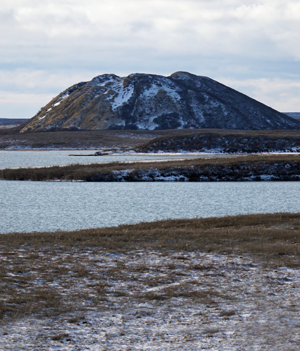
Visitor Safety

Bears
The Pingo Canadian Landmark is home to two species of bears: grizzly bear and polar bear. The grizzlies are more commonly viewed than polar bears.
A bear safety briefing is available to you at the Parks Canada Visitor Centre in Inuvik.
Follow these safety tips to avoid attracting bears:
- store and prepare food at least 50 metres away from your camp to eliminate smells that attract bears
- never store food or scented toiletries in or around your tent and use bear-proof containers to store your food and toiletries
- use unscented toiletries to avoid smells that attract bears
- practice leave no trace principles and pack out what you have packed in to ensure that bears never learn to associate humans with a food source
Follow these safety tips to avoid encounters with bears:
- travel in groups because the larger the group, the greater the chances of deterring a bear
- stay alert and watch for fresh signs of bear activity such as scat, tracks and freshly trampled plants
- when hiking, call out, sing or talk loudly to help alert bears to your presence and prevent a surprise encounter, especially near streams and in the dense shrub vegetation along valley bottoms
- if you see a bear, calmly gather group members together, do not approach the bear for a closer look and if possible, leave the area calmly
- carry bear deterrents such as bear spray and air horns and make sure you know how to use them
- if you encounter a large dead animal, leave the area immediately
If a bear acts aggressively toward you, contact the Parks Canada Duty Officer as soon as possible at 1(867)678-0705.
A note on polar bears
Polar bear behaviour is very different from that of a grizzly. Although it is unlikely that you will encounter a Polar Bear at The Pingo Canadian Landmark, they are occasionally spotted in the region.
Ensure you read the Safety in Polar Bear Country brochure and report all polar bear signs and sightings by calling the Duty Officer as soon as possible at 1(867)678-0705.
For more information on bear safety, please visit: http://www.bearsmart.com/.
Wolves and wolverine
Wolves and wolverine are found throughout the landmark. It is extremely rare for these animals to pose a threat to humans, but they are predators and may become aggressive in exceptional circumstances.
You should travel in groups and do not approach these (or any other) wild animals. In the event of aggressive behaviour, defend yourself by making noise or deploying bear spray and an air horn.
Biting insects
Repellent, bug jackets and bug hats are essential equipment. Insects are only active during the brief Arctic summer, so they pack a lot of activity into their short lives. The numbers of mosquitoes, blackflies and horseflies increase gradually in June and begin to decrease in August. July is reliably buggy.
Rabies
Be suspicious of any friendly or unusually bold animals as this can be a sign of rabies infection. As a general rule, keep a safe distance from all wildlife.
- Date modified :